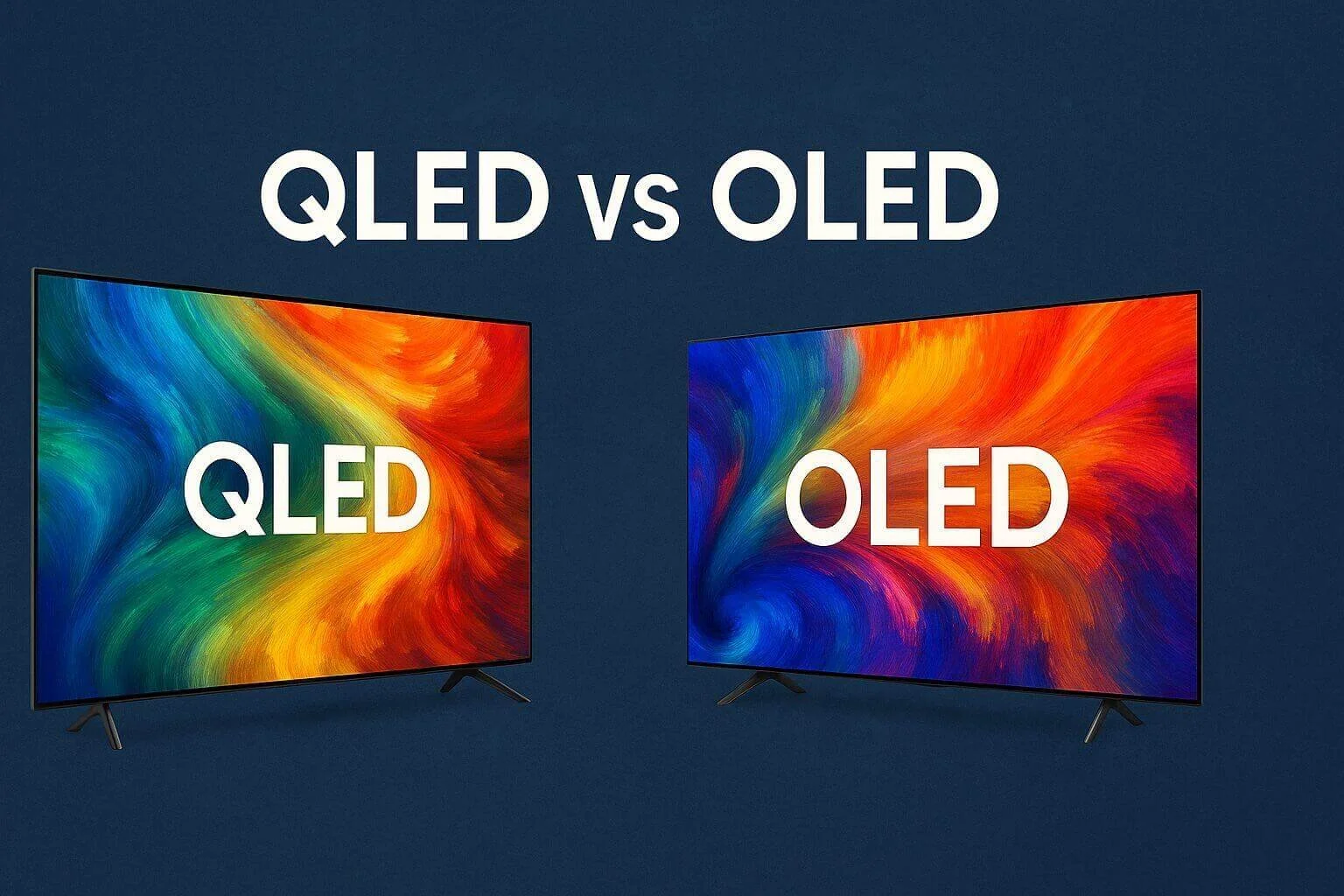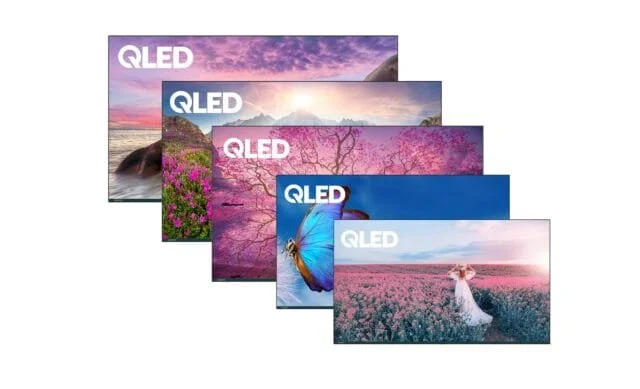QLED vs OLED: Which Display Technology is Right for Your Business?
Choosing the right display technology has never been more important for businesses. Whether you're investing in digital signage, interactive collaboration displays or presentation screens, the performance of your display impacts everything from visual impact to engagement and productivity. Whether you're investing in non-interactive displays for video meetings, presentation spaces or front-of-room installations, the performance of your display impacts everything from clarity and engagement to productivity and user experience.
Two leading technologies dominate the market: QLED and OLED. But what is the difference between OLED and QLED? And which one should you choose for your unique environment?
In this guide, we’ll compare QLED vs OLED displays, explore their pros and cons and help you make the right choice for your organization.
What is QLED?
QLED stands for Quantum Dot Light Emitting Diode. QLED displays use an LED backlight that shines through a Quantum Dot layer, which enhances colour and brightness. The result is a display that can achieve exceptionally high brightness levels and vivid colour reproduction - making it a popular choice for both consumer TVs and business displays.
What is OLED?
OLED stands for Organic Light Emitting Diode. Unlike QLED, OLED displays don’t require a backlight - instead, each individual pixel emits its own light. This means that black is produced when a pixel is switched off. The result? Outstanding contrast, incredible depth and excellent viewing angles in dynamic consumer environments and home cinema.
QLED vs OLED: Key Differences
1. Brightness
QLED delivers superior peak brightness. This makes QLED displays ideal for environments with high ambient light, such as meeting spaces, boardrooms and corporate lobbies.
OLED can produce excellent brightness too, but not at the same level as QLED. OLED performs best in controlled lighting conditions.
2. Contrast & Black Levels
OLED offers an improved black level by switching pixels off completely. This makes OLED preferred for premium visual experiences such as home cinema.
QLED still achieves strong contrast while maintaining reliably bright, punchy visuals, which is advantageous for business environments where clarity and consistency matter more than cinematic depth.
3. Colour Reproduction
Both technologies deliver vibrant, accurate colours.
OLED excels in subtle gradients and colour accuracy.
QLED, however, tends to produce more vivid and vibrant colours, which stand out in business presentations and public-facing corporate displays.
4. Viewing Angles
OLED supports ultra-wide viewing angles, which can be useful in open seating arrangements.
QLED now offers improved angles compared to older LED tech, with minimal compromise in colour or brightness, well-suited for meeting rooms and collaborative spaces with defined viewing zones.
5. Burn-In Risk
OLED panels carry a low but real risk of burn-in when displaying static content over time (such as persistent logos or UI elements within corporate environments).
QLED displays have no burn-in risk, making them a safer choice for persistent displays in meeting rooms and corporate lobbies, ad-hoc digital signage or static content applications.
6. Lifespan & Durability
Both QLED and OLED displays offer excellent durability.
QLED is typically more robust for prolonged 16/7 or 24/7 operation in corporate environments.
7. Cost
QLED displays are generally more cost-effective at larger sizes, allowing enterprises to outfit meeting spaces and corporate lobbies with outstanding visuals.
OLED displays come at a premium, particularly in larger formats and are typically reserved for applications where image quality is the absolute priority.
QLED vs OLED: Feature Comparison Table
When selecting display technology for your business, it’s important to understand how QLED and OLED perform across several key factors from brightness and contrast to colour accuracy, burn-in risk and cost-effectiveness.
Here’s a quick comparison to help guide your decision:
Still deciding? Use this table as a starting point, then let Avocor guide you to the best-fit solution.
OLED vs QLED: Which is Better for Business Displays?
There’s no universal answer - the right choice depends on your specific environment and use case.
For Professional Video Meetings & Presentations
QLED displays are typically more practical:
Cost-effective, particularly for larger sized displays like the 98” Avocor K Series.
No risk of burn-in with static content displayed between meetings.
Better suited to varied lighting conditions.
For organisation’s that don’t require touch functionality, non-interactive display options like the Avocor K Series provide a high-performance alternative to interactive displays, optimized for professional video and presentation use.
For Office Wayfinding
QLED displays are typically more practical:
Calls attention with vivid, punchy colors.
Long operational life for low-maintenance deployments.
Effective in bright or naturally-lit hallways and lobbies.
For Education
QLED displays are typically more practical:
Cost-effective.
Robust for heavy daily use.
Better suited to varied lighting conditions.
For Digital Signage
QLED is usually the better choice:
Handles bright environments.
No burn-in risk with static content.
Cost-effective at scale.
OLED can work beautifully for premium signage applications where visual impact outweighs lifespan considerations (luxury retail, museums, galleries).
Whether you’re designing classrooms, collaboration spaces or signage networks, choosing the right display tech is critical. If you’re unsure which fits your needs, our team can help.
Conclusion
QLED vs OLED is one of the most common display technology comparisons today, but the question isn't simply which is better, it's which is better for your business.
OLED delivers breathtaking contrast, true blacks and exceptional viewing angles - ideal for premium visual installations where visual impact matters above all else, such as home cinema.
QLED provides superior brightness, colour vibrancy and long-term durability, making it the more practical choice for professional applications, video meetings, static content, digital signage and high-usage environments where performance and reliability are key.
At Avocor, we understand that no two organizations have the same display requirements. That’s why our product portfolio is carefully engineered to offer the right technology for the right purpose - whether it’s the non-interactive QLED-based K Series for professional video meetings, presentations and eye-catching ad-hoc digital signage, or our G Series and E Series interactive displays designed for seamless collaboration.
Ready to upgrade your meeting rooms or signage? Use our product configurator to find your perfect match or speak with our team for expert advice.
Common FAQs
What is the difference between OLED and QLED?
OLED uses self-emitting pixels for perfect blacks and contrast; QLED uses a Quantum Dot layer and backlight for higher brightness and vivid colours.
Is OLED better than QLED?
OLED offers superior contrast and viewing angles; QLED delivers higher brightness and better durability for static content. The "better" choice depends on your use case.
Does QLED have burn-in?
No - QLED displays do not suffer from burn-in, making them ideal for digital signage and static content.
Which display is better for digital signage - OLED or QLED?
For most digital signage, QLED is the safer, more practical choice. OLED can be used selectively for premium, high-impact installations.
Is OLED or QLED better for static content displays?
QLED is better suited to static content, as it carries no risk of burn-in.
ABOUT THE AUTHOR:
Dana Corey
SVP Global Sales & GM
Avocor
Dana Corey is GM and SVP of Global sales at Avocor. As an executive team member, he is charged with leading the sales and general management functions, developing strategic direction to drive partnerships and revenue growth, provide a high level of customer service and develop strategies for expanding the company’s customer base.
In Dana's career, which spans 20+ years in high tech industries and digital transformation, he has launched and been a part of several new brands and held global executive leadership roles across enterprise, channel management, marketing and technology operations, including the likes of Barco and Prysm. His diverse technical background, with knowledge in displays, collaboration software solutions, SaaS and unified communications has contributed to the direction and continuing success of Avocor.





